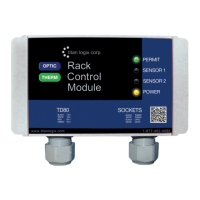TD80™ Level Gauging and Overfill Prevention System Product Manual
Rev. 2, August 4, 2015/ TD80 and Overfill Prevention System Troubleshooting Page 79
9. Overfill Prevention System fails to allow loading.
i. Ensure that HH and Spill/Fail alarms are inactive, TD80 system is operating normally.
ii. Check for a blown HH or SPILL/FAIL fuse (if installed) and replace as necessary
iii. Check for power at
Relay Module Solenoid
terminal
1. If power is present, check wiring and power to solenoid
2. Energize and de-energize solenoid by moving J10 jumper to
check for solenoid and valve operation.
3. If no power present at
solenoid terminal, check
the following:
a. Check ground
signal through HH
and FAIL relays in
5332E
Clip test light to
ground, probe at
5332E, HH-NC
and FAIL-COM
(or SPILL/FAIL –
COM on
5332E/PS
Display) to apply
ground for
loading enable.
b. Check ground at
HH-NC and FAIL-
COM in Relay
Module.
Clip test light to
ground, probe at
Relay Box, HH-
NC and FAIL-
COM to apply
ground for
loading enable.
c. Check J10 shorting jumper is in “B”
position.
d. Check PTO signal
at Relay Module.
Clip test light to
ground, probe at
Relay Box, PTO
to apply ground
for loading
enable.
4. Inspect for broken or corroded wiring and repair as necessary.
i. Ensure that HH and Spill/Fail alarms are inactive, TD80 system is operating normally.
ii. Check for a blown HH or SPILL/FAIL fuse and replace as necessary
iii. Check J10 shorting jumper is in “A” position for 5332E/PS (red terminal board Display) or
“B” position for 5332E (green terminal board display).
iv. Check that the LED to fiber optic cable is illuminated.
v. If the LED is OFF, then troubleshoot the 5332E for HH and FAIL relay fault or open wiring.
vi. If the LED is ON, then troubleshoot the fiber optic cable, P2000 and wiring to Scully socket.
vii. Inspect for broken or corroded wiring and repair as necessary.

